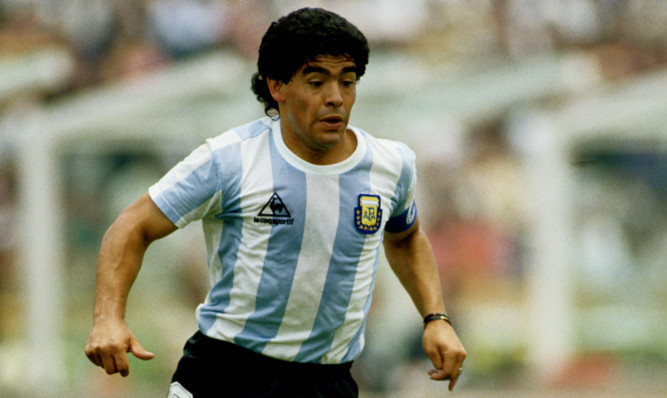
The ten best outfield players to represent Real or Barcelona. One rule: mere mortals need not apply.
Real Madrid:
Alfredo Di Stefano: The man all Madrid fans refer to as ‘The Don’. Di Stefano was the catalyst behind the Real side that won the first five European Cups which helped to establish the club legend all over the world.
It has often been said that Di Stefano wasn’t the conductor of the orchestra, he was the orchestra. Perhaps not more recognised because of a lack of international success, but this scorer and maker of goals should be ranked alongside the likes of Pele and Maradona.
Ferenc Puskas: Overweight, over the hill and totally one-footed. That was the myth when Ferenc Puskas joined Real Madrid aged 31.
But people didn’t realise just how good that wand of a left foot was. He didn’t need to use his right when his left was so special.
He was top scorer in La Liga in four of his first five seasons in Spain, but the biggest achievement was scoring four in Real’s famous 7-3 demolition of Eintracht Frankfurt in the 1960 European Cup final.
In the 55 years that have followed, no one has matched Puskas’ feat.
Raul: Raul Gonzalez Blanco was not the quickest or the strongest player, and he was very left-footed, but don’t tell Real Madrid fans, this guy wasn’t special.
Pinched from neighbours Atletico Madrid as a teenager, Raul would become the symbol of Real’s return to greatness on the European stage, as they won three Champions Leagues between 1998 and 2002.
He was the man for the big occasion, scoring the big goals when it mattered most.
Zinedine Zidane: The Bernabeu probably only saw fleeting glimpses of the best of Zidane after his world record £45 million move from Juventus in 2001.
But he gave them ‘La Novena’, the ninth of their European Cup triumphs with his spectacular volley against Bayer Leverkusen. It was the perfect goal to win such an important game, and an enduring memory of Zidane’s class.
Cristiano Ronaldo: The rivalry with Barcelona nemesis Messi has spurred Ronaldo onto incredible heights in his career. He has worked hard, got stronger, and scored more goals to help his team overcome the challenge of Barcelona and try to win his own personal duel.
Messi leads 3-1 in Champions League titles and 4-3 in World Player of the Year awards, but that is not important. We are privileged that we can watch them both at the peak of their powers.
Ronaldo’s athletic prowess and insatiable desire to score mark him out as an all-time great.
Barcelona:
Johan Cruyff: It was the arrival of this gifted player from Holland that opened Barcelona’s eyes to a new way of playing, and the style we still watch today.
Cruyff was a world record signing back in 1973 when he joined and his arrival ended a 14-year wait to win La Liga.
It was worth it simply for his orchestration of Barca’s 5-0 win over Real at the Bernabeu and the mass outpouring of joy it gave to the Catalan people.
Diego Maradona: His two years in Spain probably didn’t see the best of Maradona, but he has to be included in a list of Barcelona’s greatest. He arrived for a world record fee and departed for one when he left for Napoli.
His time with the Catalan giants was hampered by illness and injury, but watch this goal in a victory over Real at the Bernabeu and see just how special this guy was.
Xavi: The definition of the midfield maestro. For those connoisseurs of the beautiful game, here was a gift from the Gods.
Xavi was schooled in the ways of Barcelona from a young age and is probably the personification of ‘Tiki-Taka’ football.
The triangle of him, Messi and Iniesta was at its height in the 2011 Champions League final against Manchester United when they put on a masterclass of keeping the ball, probing away and picking gaps in the opposition defence.
Andres Iniesta: Andres Iniesta doesn’t have the gold dust that some of these other superstars do, but when he retires, we will look back on him as an all-time great.
He has to be included with Xavi and Messi for forming possibly the best ever trio of footballers in the same team. A gifted midfielder with an eye for a pass, he’s also scored two of the most famous goals in the last decade.
His strike in injury time against Chelsea that took Barca to the Champions League final in 2009 and the one that won the World Cup for Spain a year later are ones for the ages.
Lionel Messi: Watching the little Argentine torment Manchester City’s players on Wednesday night was to witness a genius at work. Still only 27, it’s hard to believe that he has been doing that now for over a decade. When he helped Barcelona win the treble in 2008/09, he smashed in 38 goals. Since then, he has never scored less than 40 in a season as we can only marvel at his astonishing consistency and excellence.

Enjoy the convenience of having The Sunday Post delivered as a digital ePaper straight to your smartphone, tablet or computer.
Subscribe for only £5.49 a month and enjoy all the benefits of the printed paper as a digital replica.
Subscribe